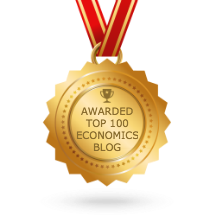Sees strong likelihood that consumers face higher prices while unemployment rises because of tariff increases
By Nick Timiraos of The WSJ. Excerpts:
[Federal Reserve Chair Jerome] "Powell said he saw a “strong likelihood” that consumers would face higher prices and that the economy would see higher unemployment as a result of tariffs in the short run.
This would create a “challenging scenario” for the central bank because anything it does with interest rates to address inflationary pressures could worsen unemployment, and vice versa, he said. “It’s a difficult place for a central bank to be, in terms of what to do,” Powell said during a moderated discussion at the Economic Club of Chicago."
"When determining how to set interest rates in such a scenario, the Fed would weigh how far inflation is from its 2% target, how weak the labor market becomes and how long it could take for both of those variables to improve.
Powell also hinted that the central bank could give priority to its inflation goal over its labor-market mandate if the two were in conflict. The Fed would attempt to balance the two goals, “keeping in mind that, without price stability, we cannot achieve the long periods of strong labor market conditions that benefit all Americans,” he said.
The Fed’s focus, he said, will be to ensure that any one-time increases in prices from tariffs don’t fuel more persistent price increases."
"Powell suggested that the postpandemic experience was top of mind for policymakers who are now confronting new shocks to global supply chains from tariffs. Powell pointed to carmakers and their assembly chains as one example of economic activity that could be “disrupted significantly” by tariffs."
"the Fed is likely to hold back from lowering interest rates, which can stimulate demand by spurring purchases of interest-rate sensitive goods, until it sees an increase in joblessness."
It mentions lowering interest rates to increase demand. But if prices have just gone up throughout the economy, that could mean more inflation. The Fed could raise interest rates to reduce demand to lower the pressure on prices. But that might also reduce output and raise the unemployment rate.
This dilemma is illustrated in the graph below. AD stands for aggregate demand or demand for all goods and services. P is the price level like the CPI. Q is the output of all goods and services (or real GDP). QF is the full-employment GDP. That is the highest level of real GDP that also keeps prices stable (inflation no more than 2%). It is not possible to stay above this level for very long and it will probably mean creating alot more inflation.
The graph shows a decrease in supply (SRAS1 to SRAS2), raising prices and lowering output (with the unemployment rate increasing).
If the Fed raises interest rates, AD will shift to the left, lowering prices (but maybe not much since we are in the relatively flat part of SRAS). This reduces total output on top of the reduction caused by SRAS shifting. We probably don't want to do that.
But if the Fed cuts interest rates AD will shift to the right. That is okay as long as that happens in the relatively flat part of SRAS because prices won't go up that much. But it is hard to know ahead of time whether or not how far AD will move and if it will push us past QF. It does seem like the article hints that doing this might be okay. Near the end some other Fed officials offer a slightly different opinion than Powell's.

No comments:
Post a Comment